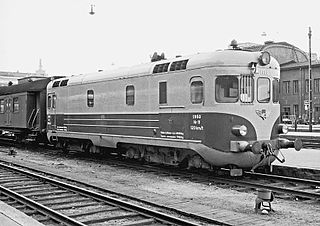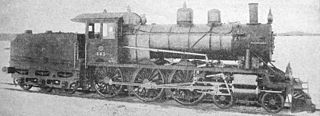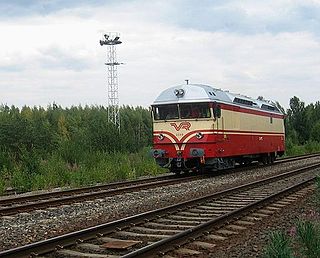
VR-Group Plc, commonly known as VR, is a government-owned railway company in Finland. VR's most important function is the operation of Finland's passenger rail services with 250 long-distance and 800 commuter rail services every day. With 7,500 employees and net sales of €1,251 million in 2017, VR is one of the most significant operators in the Finnish public transport market area.

Under the Whyte notation for the classification of steam locomotives, 4-6-2 represents the wheel arrangement of four leading wheels on two axles, six powered and coupled driving wheels on three axles and two trailing wheels on one axle. The 4-6-2 locomotive became almost globally known as a Pacific type after a New Zealand locomotive that was shipped across the Pacific Ocean.

4-4-0 is a locomotive type with a classification that uses the Whyte notation for the classification of steam locomotives by wheel arrangement and represents the arrangement: four leading wheels on two axles, four powered and coupled driving wheels on two axles, and a lack of trailing wheels. Due to the large number of the type that were produced and used in the United States, the 4-4-0 is most commonly known as the "American" or "Eight-Wheeler" type, but the type subsequently also became popular in the United Kingdom, where large numbers were produced.

Under the Whyte notation for the classification of steam locomotives, a 2-6-4 locomotive has two leading wheels, six coupled driving wheels and four trailing wheels.

The K class was a branch line steam locomotive that ran on Victorian Railways in Australia from 1922 to 1979. Although its design was entirely conventional and its specifications unremarkable, the K class was in practice a remarkably versatile and dependable locomotive. It went on to outlast every other class of steam locomotive in regular service on the VR, and no fewer than 21 examples of the 53 originally built have survived into preservation.

The N class was a branch line steam locomotive that ran on the Victorian Railways (VR) from 1925 to 1966. A development of the successful K class 2-8-0, it was the first VR locomotive class designed for possible conversion from 5 ft 3 in to 4 ft 8+1⁄2 instandard gauge.

The R class was an express passenger steam locomotive that ran on Australia's Victorian Railways (VR) from 1951 to 1974. A long overdue replacement for the 1907-era A2 class 4-6-0, their development and construction was repeatedly delayed due to financial constraints caused by the Great Depression and later the manpower and materials shortages of World War II and the immediate postwar period.
The DD class (later reclassified into D1, D2 and D3 subclasses) was a passenger and mixed traffic steam locomotive that ran on Victorian Railways from 1902 to 1974. Originally introduced on mainline express passenger services, they were quickly superseded by the much larger A2 class and were relegated to secondary and branch line passenger and goods service, where they gave excellent service for the next fifty years. The DD design was adapted into a 4-6-2T tank locomotive for suburban passenger use, the DDE (later D4) class. They were the most numerous locomotive class on the VR, with a total of 261 DD and 58 locomotives built.
The history of rail transport in Finland began on January 31, 1862, with the opening of the railway line between Helsinki and Hämeenlinna. By 1900 most of the future main lines had been constructed, including the line to St. Petersburg. By the time of the birth of the new Finnish Republic in 1917 lines connected all major cities, major ports, and reached as far as the Swedish border, and inner Finland as far north as Kontiomäki in Paltamo region, as well as eastwards into Karelia.

The VR Class Hr11 was the first class of line-haul diesel locomotives used by Valtionrautatiet. Only five units were built, all delivered by Valmet in 1955. The Maybach diesel engines used in the locomotives proved highly unreliable, resulting in a complete overhaul of the engine-transmission system in 1956–58, but this did not solve all of the reliability problems. The Hr11 series was withdrawn from service in 1972.

The Hr1 class was the largest passenger express steam locomotive built in Finland. Twenty-two were built between the years 1937–1957. They were numbered 1000–1021.

The Finnish VR Class Tk3 was a 2-8-0 light freight locomotive. It was the most numerous steam locomotive class in Finland with 161 built. 100 locomotives were constructed between 1927 and 1930, with a further 61 ordered and constructed 1943–53. They were numbered 800–899, 1100–1118, and 1129–1170.

VR Class Pr1 was a tank steam locomotive for local passenger services of Finnish railways.

The Finnish VR Class Hv1 was a 4-6-0 express passenger train locomotive. 42 were built between 1915 and 1921. They were numbered 545–578 and 648–655.

The VR Class Tr1 is a class of heavy freight locomotive built in Finland and Germany. Before 1942 VR Class Tr1s originally had the class name R1. They were nicknamed “Risto”, after the Finnish President Risto Ryti. They were numbered 1030–1096.

VR Class Tve2 was a VR Group diesel shunting locomotive. They were ordered from the Saalasti Oy engineering company and built between 1962 and 1964. Locomotives was sent to the Turenki sugar factory. A total of 8 units. The manufacturer's designation for the model was OTSO2 and OTSO2/VR.

VR Class Dr12 was a heavy diesel-electric locomotive of Valtionrautatiet. The first 6 locomotives were ordered in 1956. They entered service between 1959 and 1963. The locomotives were built by 2 manufacturers, Valmet and Lokomo, both based in Tampere. All Hr12 class locomotives with even numbers were produced by Valmet, while all odd numbers were produced by Lokomo. The locomotives were withdrawn in the early 1990s.

VR Class Dr13 was a heavy diesel locomotive used by VR Group. The Dr13 was designed by the French company Alstom. The class consisted of 54 locomotives, of which the first two were built by Alstom’s factory in Belfort, France and were shipped to Finland in 1962, while the rest were built in Tampere at the factories of Lokomo and Valmet. The first Dr13 series locomotive came to Finland on 24 October 1962. The Dr13 series was introduced between 1962 and 1963, and the last units were withdrawn by June 2000.

The VR Class Ds1 Also known as "Puumotti" was the first railbus of the Finnish State Railways. It was ordered in 1927. The Ds1 was built by the Pasila workshop, but the automotive parts including the engine were supplied by the Swedish company DEVA. Ds1 has a diesel engine and an electric drive, with a diesel generator providing power to the wheels. A cab is at either end of the vehicle, so that the vehicle did not have to be turned at terminal stations. The vehicle consisted of a motor room, a luggage compartment, and a 3rd class passenger compartment bare on a wooden bench seating.

The VR Class Vk11 No 101 locomotive was purchased for testing on a six-mile stretch of track between Vuokatti and Sotkamo, where the use of steam locomotives had proved to be uneconomical due to low traffic. The locomotive was ordered from the Swedish act called Ab Slipmaterial of Sweden, and it was completed in 1930. The locomotive had a six-litre Wisconsin petrol-paraffin internal-combustion engine. In January 1931 the locomotive was delivered to Finland, it initially received the number Mt 101. Another very similar locomotive was ordered home in 1935. It was built by Lokomo in Finland and had an 80 hp paraffin Andros petrol-paraffin engine. It initially received the number Mt 102. In 1953 locomotive class designation was changed to Vk11, and in 1962 they were renumbered again to Tve-ko1 and Tve-ko2. Vk11 locomotives were broadly similar to each other, but there were a number of detail differences. Both were two-axle and weighing 12 tons. Both had engines that ran on kerosene / paraffin as fuel but required gasoline / petrol to start them. Locomotives had different lengths of 5.6 m and 6.0 m. Locomotive Vk11 No. 101 was tested on Vuokatti-Sotkamo line for four months. When the passenger rail in this case was discontinued, it was transferred to the locomotive workshop in Oulu on internal traffic. In 1935, the locomotive was placed in a shunting yard in Siuro. After that the locomotive was used at Vaasa and the workshop at Oulu as a shunter. The locomotive was withdrawn in 1962.



















